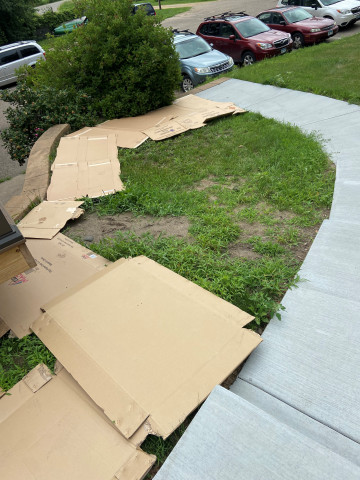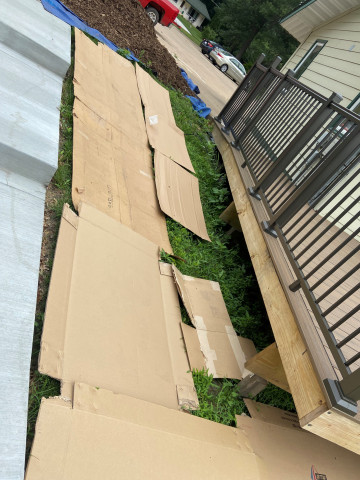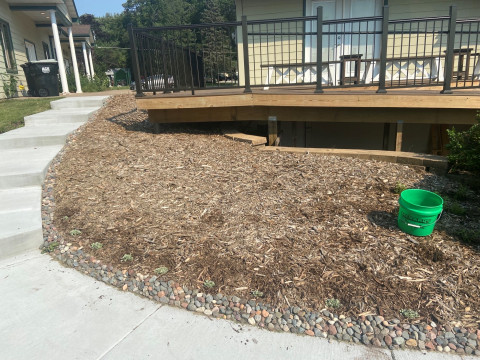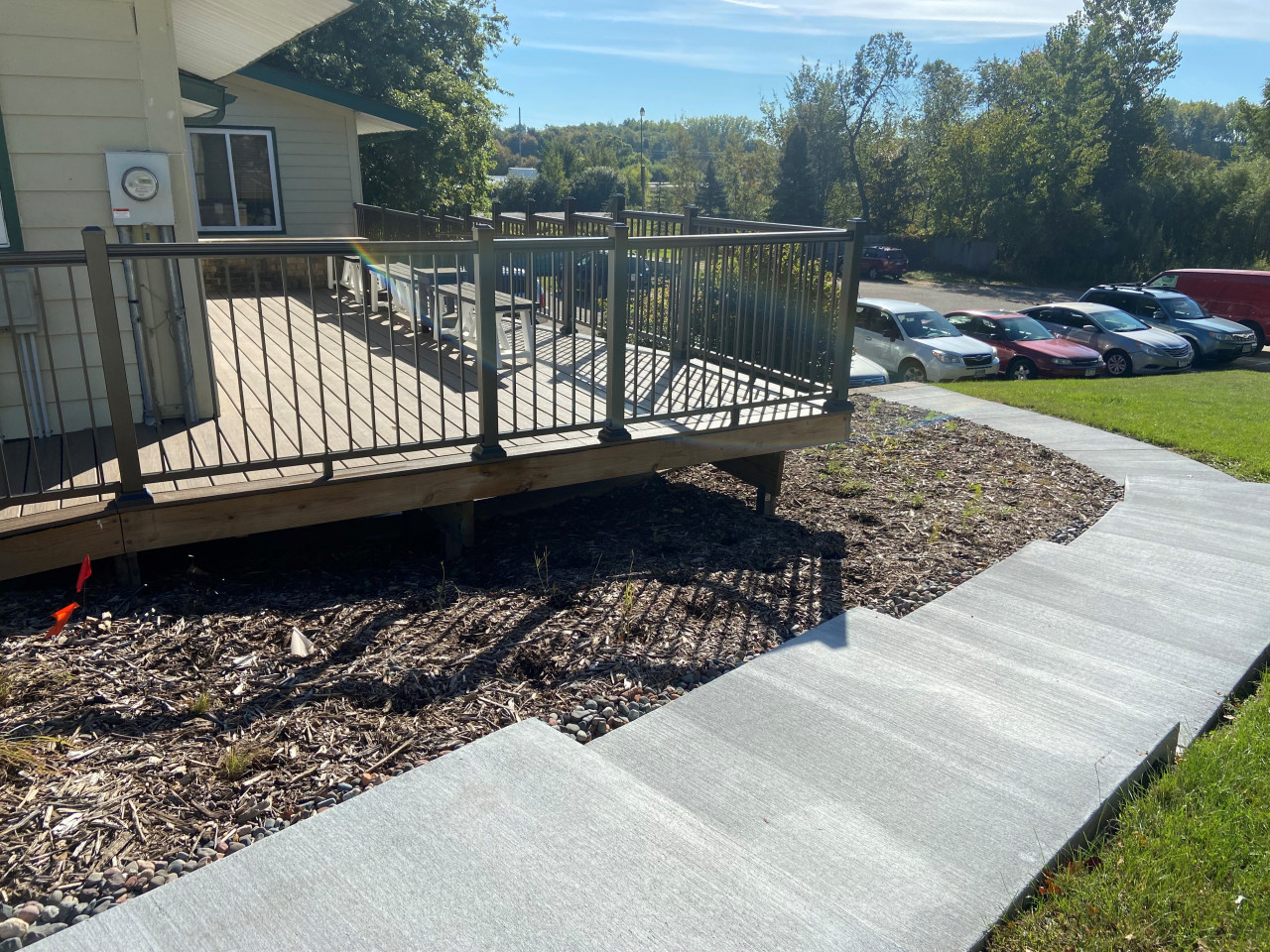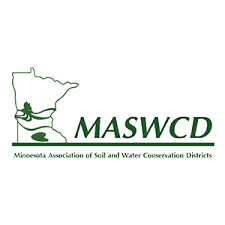In Anoka County, the Rum and Mississippi Rivers are designated State Water Trails. Like many state trails, information is available about trail access, places to camp, culturally significant areas, and more on the MNDNR's water trails website. ACD is completing a number of projects along both rivers to improve water quality and habitat. We've been especially busy with projects along the Rum River that include wetland restorations, riverbank stabilizations, invasive species management, and habitat protection. Many of these projects are funded in part by the Clean Water, Land and Legacy Amendment.
Plant species that are "native" to a local area (i.e., grow there naturally) provide necessary food and habitat for pollinators and enhance soil and water quality. Outdoor spaces that are in covered in turf provide very few benefits to pollinators or the environment, so frequent pockets of natural spaces are critical in developed areas. We recently converted part of our office property from an area that was annoying to mow into beneficial pollinator habitat! Here's how we did it:
In early summer, we used "sheet mulching" to kill off the grass and weeds. If you can plan to have a couple of months before planting, this is an easy method to prepare a site without using herbicides. The future garden space was fully covered in cardboard sourced from our local recycling facility and then covered with a couple inches of mulch. This effectively smothered existing weeds.
We selected 11 native wildflower species, 2 native shrub species, and 2 native grass species for the garden that will thrive with the amount of natural sun and water that the spot gets. Adding wildflowers is a no-brainer to provide nectar for pollinators, but adding grasses sometimes gets overlooked in pollinator gardens. Native grasses provide homes for insects to overwinter in and add beautiful texture to a space! There are many great places to order native plants from in Minnesota; we used Minnesota Native Landscapes and Glacial Ridge Growers.
Since our garden is next to a sidewalk, it was lined with river rock to create a cleaner look and contain the mulch.
In early fall, the plants arrived and were planted. By this time, the cardboard underneath had broken down enough that it was easy to rip gaps in it to dig holes for the plants. Autumn planting gives plants an edge for developing strong roots in their new home and is a great option if you miss the spring planting window. The plants were spaced about 1.5 feet apart to leave them with room to grow into their full-sized forms. The already-present mulch will help hold in water and continue to suppress weeds.
It will be exciting to watch these new plants grow over the coming year to create a beautiful spot that will support some of our essential pollinator species in Anoka County.
You can also follow these steps to convert areas of your property that may not get much traffic or are hard to mow into a space that will benefit everyone!
We have all noticed spiders in our homes or when we are out for a walk. Most of the time, we view them as gross or something to fear. Instead of instantly thinking of spiders as pests that we want to kill or remove from the home, we should try to gain a better understanding of the important role these creatures play within the ecosystem.
Minnesota is home to 519 different species of spiders, including a species of 'jumping spider' that has only been found in Anoka County. 7 of the spider species found in the state are poisonous, but a spider bite resulting in death hasn't been recorded in the United States for decades. Less than 0.5% of spider bites lead to major medical complications.
The main benefit that spiders provide is that they eat a massive amount of insects, consuming on average between 400 and 800 million tons of bugs globally every year. Not only do spiders eat common pests like mosquitos and flies, they also act as a natural insecticide, eating many insects that are known for destroying crops or gardens.
To learn more about why spiders are important, please visit our friends at the Three Rivers Park District: https://www.threeriversparks.org/blog/myths-and-facts-spiders
The Mount Simon-Hinckley aquifer is one of the deepest and oldest aquifers in the state. It runs from Hinckley, MN to a large swath of south central Minnesota. The aquifer reaches depths of over 1,000 feet in some areas, containing water that is 30,000 years old. Industrial pumping of the aquifer has been banned in the seven county metro area for more than 30 years, and household use is only allowed when there is no other reasonable water alternative. Even with current restrictions, demand on the aquifer is likely to increase in the future due to projected climate conditions.
Many people think of aquifers as large underground lakes, but really an aquifer is more like sand soaked water where water trickles down through the porous space. This trickle of water may be extremely slow and it may take years for water to reach the aquifer. This leads to issues when aquifers are over-pumped and this slower recharge rate is not taken into account. There are already known areas in the Mount Simon Aquifer that are dry, caused by excessive pumping.
The Mount Simon Hinckley aquifer is an especially complicated system because of the diversity of the landscape it covers. These different landscapes have unique water flow as well as varying rock types which influence the water's ability to percolate down. Water within the same aquifer may differ in age by a thousand years depending on when the water reached the aquifer. Age of the water can be an indicator of water supply.
Learn more about how groundwater systems work by watching ACD's "Our Groundwater Connection" informational video.
Anoka Conservation District (ACD) Supervisors, Mary Jo Truchon, Glenda Meixell, and Colleen Werdien, along with District Manager Chris Lord, attended the Minnesota Association of Soil and Water Conservation Districts (MASWCD) annual meeting for 2021.
The MASWCD convention is a great opportunity for SWCD supervisors and staff to learn more about current natural resource issues in Minnesota. The conference features grassroots initiatives to conserve soil and water resources throughout the state and always provides attendees with new ideas that can be applied on the local level. Keynote speaker, National Geographic Photographer Jim Richardson, presented on the increased strain on the planet in order to feed the growing population and offered a unique opportunity to learn about global agriculture issues and the potential solutions we have to address them.
In addition to sessions on a variety of conservation topics, discussions and votes were held for state natural resource resolutions. Several awards were presented including; Outstanding Community Conservationist Award, Outstanding Forest Steward Award, Minnesota DNR Division of Waters Appreciation Award, and the Outstanding SWCD Employee and Supervisor awards, presented by the Board of Water and Soil Resources. The convention also featured a luncheon, where the SWCD of the Year Award was presented, along with recognition to outstanding conservationists across the state. The City of Anoka was recognized as Anoka County's Outstanding Conservationist for 2021.
2019 was another banner year for precipitation in Minnesota, with over 20 individual annual precipitation records set, and the state turning in its wettest year on record.
Precipitation totals for the year exceeded 30 inches over all but about 5-10% of the state, mainly in far northern Minnesota, with totals exceeding 50 inches in parts of southern and southeastern Minnesota. Well over half of the state was 12-20 inches (or 50-70%) wetter than normal. Annual surpluses of that magnitude over such a large area contributed to 2019 being Minnesota's wettest year on record, on a statewide-average basis, with an average of 35.51 inches. This eclipsed the old record of 33.93 inches, set in 1977.
Although no climate observing station was able to break the statewide individual annual precipitation record of 60.21 inches set by Harmony in 2018, many stations with over 50 years of observations did break their own annual precipitation records. Rochester International Airport led the pack with 55.16 inches, breaking its old record by more than 11 inches.
The Twin Cities International airport, part of the longest station history in the state, had just broken its record in 2016, but broke it again in 2019, with 44.17 inches. Other records fell throughout the state. The majority of these stations broke records that had been set this decade.
Even closer to home, the ACD has utilized the precipitation data collected by our volunteer observers to assist with putting our monitoring well data in context. We have observed sustained wetland hydrology because of the abundance of precipitation. How this will affect how wetlands are managed in the present and future will need to be addressed by the current wetland regulatory rules and by utilizing the data we collect when reviewing wetland delineations.
This information is provided at the DNR Climate website:https://www.dnr.state.mn.us/climate/journal/top-weather-and-climate-stories-2010s.html
Here is a partial list of the records set this year.
| |
| Station | 2019 Precip records (in.) | Previous record(yr.) |
| Rochester | 55.16 | 43.94 (1990) |
| Owatonna | 53.50 | 48.40 (2016) |
| Zumbrota | 48.60 | 45.52 (2010) |
| Lake City | 43.85 | 43.59 (2002) |
| Minneapolis - St. Paul | 43.17 | 40.32 (2016) |
| Mora | 43.08 | 41.63 (2010) |
| U of M St. Paul | 42.95 | 41.67 (2016) |
| St. Cloud | 41.92 | 41.01 (1897) |
| Itasca U of M | 37.59 | 35.64 (1985) |
| | | |
De-icing salt is so common here in snowy Minnesota, we hardly even think before tossing it down. But we really should be thinking hard because all that salt accumulates in local streams, lakes, and wetlands causing stress and sometimes death to native animals and vegetation. Salt dissolves easily in water which means it's almost impossible to remove without expensive and time-consuming treatment. Road and sidewalk safety is a priority for all of us, so what is an environmentally conscious Minnesotan to do if they want to stay safe and minimize their salt use? Here are some tips!
Shovel First. Shovel and scrape sidewalks before they are walked on so ice doesn't have a chance to form in the first place.
Choose the Right Salt. Different chemicals work at different pavement temperatures. Be sure to choose the right one for the conditions. Sodium chloride, the most common de-icer, will only work when the pavement temperature is above 15 degrees F.
Scatter Salt Grains. Granular salt melts ice fastest when the grains are spread 3 inches apart. Contrary to popular belief, adding more salt will actually make the ice melt slower!
Sweep up Excess. If there is salt left on the ground after all the ice is gone, sweep it into a bucket to use in the next storm. You paid for it so don't let it wash away!
Pre-treat Pavement. Applying a liquid de-icer to pavement 24-48 hours before a storm will help prevent ice from adhering to the surface and make it a lot easier to scrape up.
Wear Proper Footwear. Boots with extra traction such as cleats or spikes reduce the risk that you may slip and fall. They are a worthwhile investment here in Minnesota where we're bound to encounter ice at some point.
Avoid Distractions. We all know not to drive while we're distracted. The same goes for walking! Avoid using cell phones while walking and keep your eyes on the path in front of you.
Drive for the Conditions. Here in Minnesota, there is no escaping the snow and ice. Remember that you are ultimately responsible for your own safety, so always drive with caution.
Do the Penguin Shuffle. Always anticipate icy conditions and keep yourself safe by walking on marked paths near handrails.
If you See Something, Say Something! As an environmentally conscious Minnesotan, one of the best things you can do to combat chloride pollution in our waters is to talk to your friends, neighbors, and local businesses. Pressure from residents like you can help turn the tide and protect our valuable freshwater resources now and for many generations to come.

